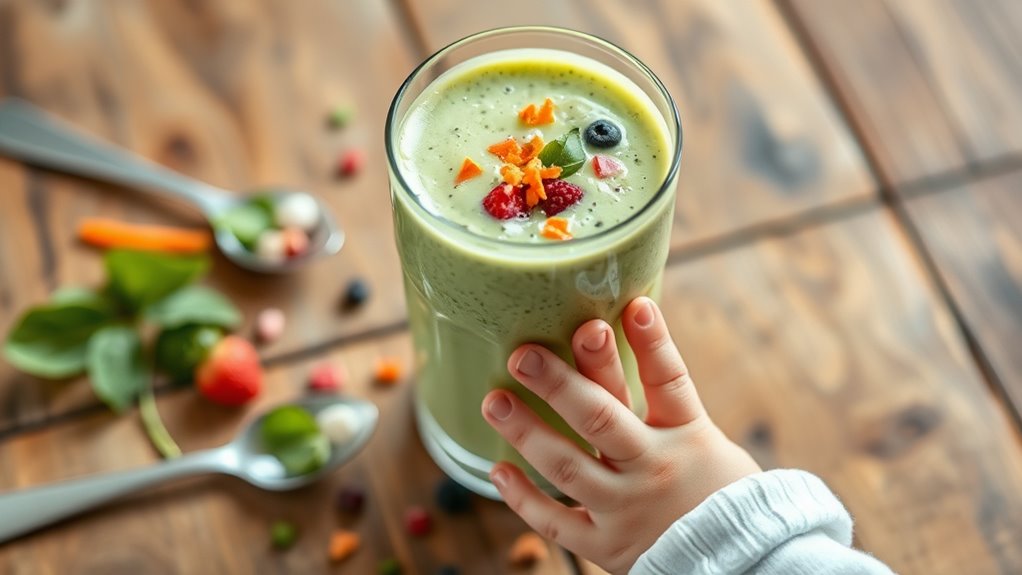To sneak veggies into a toddler’s diet, blend mild-flavored greens like spinach or zucchini into sweet, familiar fruit smoothies such as strawberry-banana or mango-pineapple. Use creamy textures from Greek yogurt or frozen fruit to mask any vegetable taste and make the smoothie feel indulgent. Get your child involved in choosing fruits or helping blend to increase their interest. Keep trying gradually, and you’ll discover more clever ways to make veggies irresistible.
Key Takeaways
- Incorporate mild-tasting vegetables like spinach or zucchini into familiar fruit smoothies for gradual acceptance.
- Use creamy textures with Greek yogurt or silken tofu to mask vegetable fibers and create a smooth, appealing consistency.
- Blend a small amount of vegetables with sweet fruits like berries or mangoes to enhance flavor and reduce detectable vegetable taste.
- Involve toddlers in selecting fruits and help with blending to increase curiosity and willingness to try hidden veggie smoothies.
- Add natural sweeteners such as honey or a splash of juice to make the smoothie more irresistible and overshadow vegetable flavors.

If your child is a picky eater who turns up their nose at most fruits and vegetables, creating a smoothie that appeals to their taste buds might be the solution. The key is to experiment with fruit combinations that naturally complement each other, making the smoothie tasty enough to entice even the most selective eater. Think ripe bananas, sweet berries, or juicy mangoes—these fruits add natural sweetness and mask the less appealing flavors of veggies. By blending together a mix of fruits, you can create a flavor profile that’s both familiar and appealing, encouraging your child to sip without suspicion.
Texture masking is equally important. Many kids dislike the gritty or fibrous feel of certain vegetables, so you want to choose ingredients that blend smoothly. Frozen fruits, Greek yogurt, or even silken tofu can help create a creamy, velvety consistency that feels indulgent rather than rough. When you blend these ingredients thoroughly, the texture becomes seamless, disguising any unwanted vegetable bits and making the smoothie more appealing to your child’s senses. The smoother the texture, the less likely they are to pick out unfamiliar ingredients.
Start with small amounts of vegetables like spinach or zucchini, which have mild flavors that blend well with sweet fruits. Incorporate a handful of greens into the fruit combination, and gradually increase the amount over time as your child gets used to the taste. Using fruit combinations that are familiar and beloved, like strawberry-banana or mango-pineapple, helps ease their acceptance. The sweetness from the fruit overrides the vegetable taste, and with consistent exposure, your child might become more open to trying new ingredients.
Another trick is to add a splash of juice or a dash of honey to enhance sweetness, making the smoothie even more irresistible. Remember, the goal is to make the drink so delicious that your child forgets they’re eating vegetables. You can also involve them in choosing the fruits or helping with the blending process, making it a fun activity that fosters curiosity and willingness to try new flavors. Over time, as they associate smoothies with tasty, fun treats, their acceptance of vegetables mixed in will likely grow.
In the end, successful sneaking of veggies into your child’s diet hinges on clever fruit combinations and effective texture masking. By prioritizing taste and mouthfeel, you turn a potentially disliked vegetable into a hidden, nourishing ingredient that supports their growth without resistance.
Frequently Asked Questions
Can I Substitute Fruits in the Smoothie Recipe?
You can absolutely substitute fruits in your smoothie recipe with fruit alternatives or ingredient substitutions. If you’re out of a specific fruit or want to try something new, feel free to swap in berries, mango, or banana. Just keep in mind that different fruits might change the flavor and texture slightly. Experimenting with different options can make your smoothie more exciting and tailored to your taste preferences.
How Can I Enhance the Flavor for Picky Toddlers?
To enhance flavor for picky toddlers, focus on flavor masking techniques and natural sweeteners. You can add a splash of vanilla or a pinch of cinnamon to make the smoothie more appealing. Use natural sweeteners like honey or ripe bananas to boost sweetness without overpowering the taste. Mixing in small amounts of kid-friendly ingredients helps mask strong veggie flavors, making the smoothie both nutritious and inviting for little ones.
Are There Any Allergens to Watch For?
While you’re sneaking veggies into smoothies, you should also consider allergen identification to keep your toddler safe. Watch for cross reactivity concerns, especially with common allergens like nuts, dairy, or soy. Even natural ingredients can sometimes trigger reactions. Always check labels, introduce new foods gradually, and consult with your pediatrician if you notice any unusual symptoms. Safety first guarantees your little one enjoys healthy, nutritious smoothies without worries.
What’S the Best Way to Store Leftover Smoothies?
When storing leftover smoothies, follow these smoothie storage tips to guarantee leftover smoothie safety. Transfer the smoothie into an airtight container or a sealed jar, leaving some space for expansion. Keep it in the refrigerator and consume within 24-48 hours. Always shake or stir before serving to mix any separation. Proper storage prevents spoilage and preserves flavor, making it safe and tasty for your little one to enjoy later.
How Often Should I Serve Smoothies to My Child?
Did you know that offering smoothies 2-3 times a week can boost your child’s nutritional benefits? You should serve smoothies regularly but not daily, allowing for ingredient variations to keep things exciting and balanced. This approach guarantees your child gets essential vitamins and minerals without over-relying on one type of snack. By varying ingredients, you make smoothies both nutritious and enjoyable, supporting healthy growth and development.
Conclusion
You’re like a gardener gently coaxing a shy flower into bloom. Just as blending hidden veggies into a smoothie can turn a stubborn eater into a veggie lover, patience and creativity help nurture healthy habits. Remember, every small sip is a step toward a colorful, nourished future. Keep experimenting and celebrating those tiny victories—you’re planting seeds for a lifetime of good choices, one delicious sip at a time.










